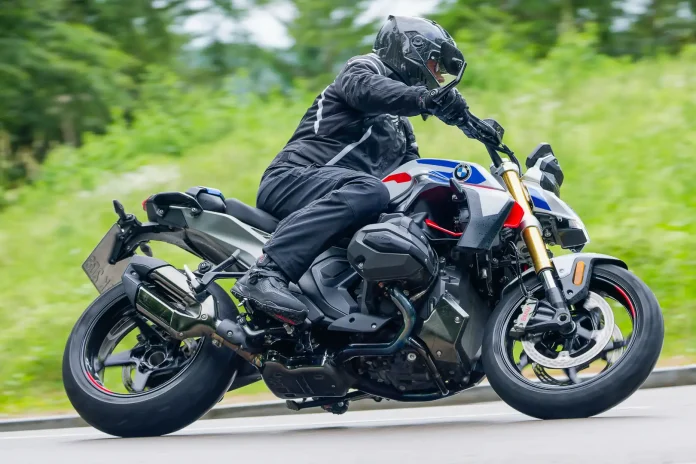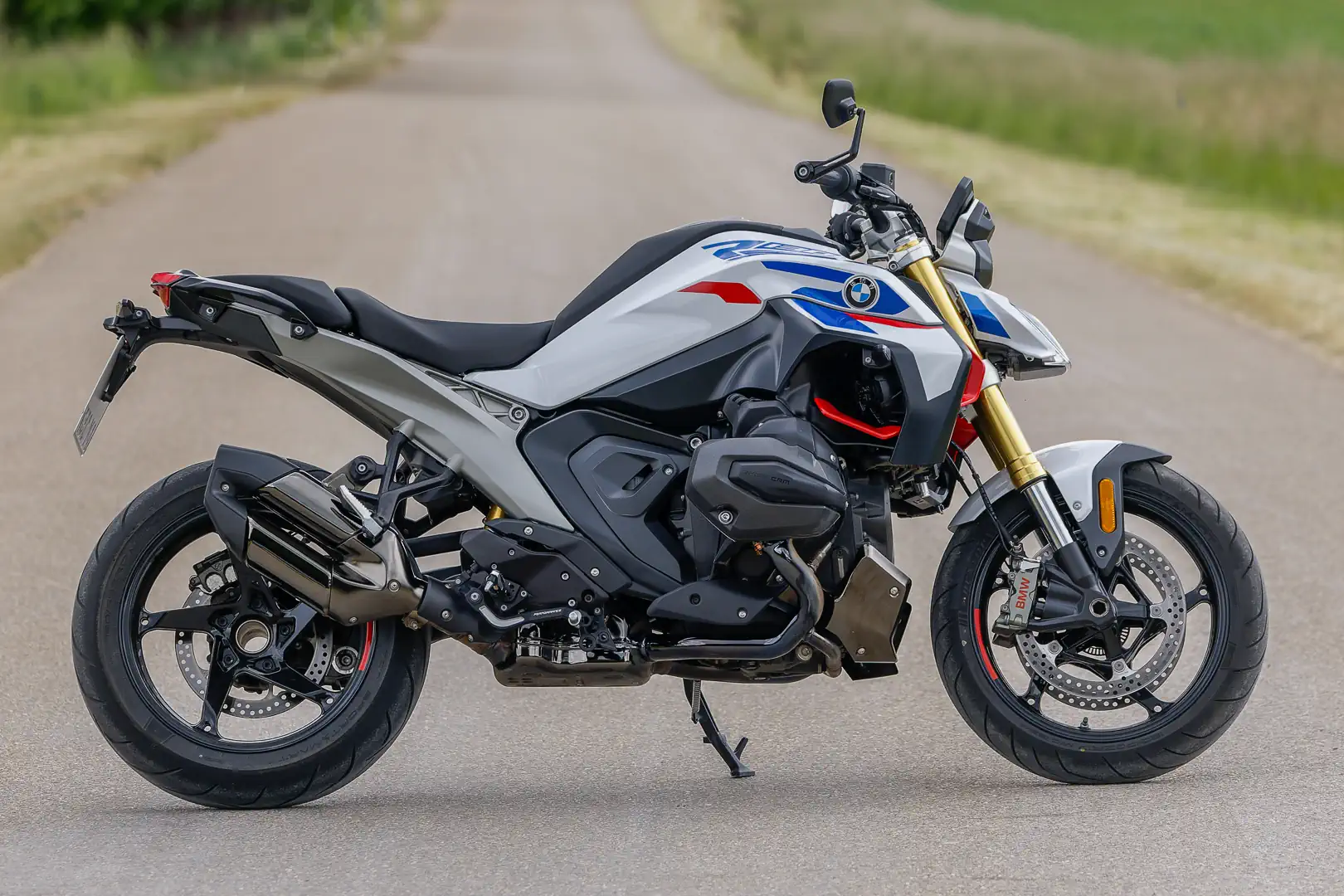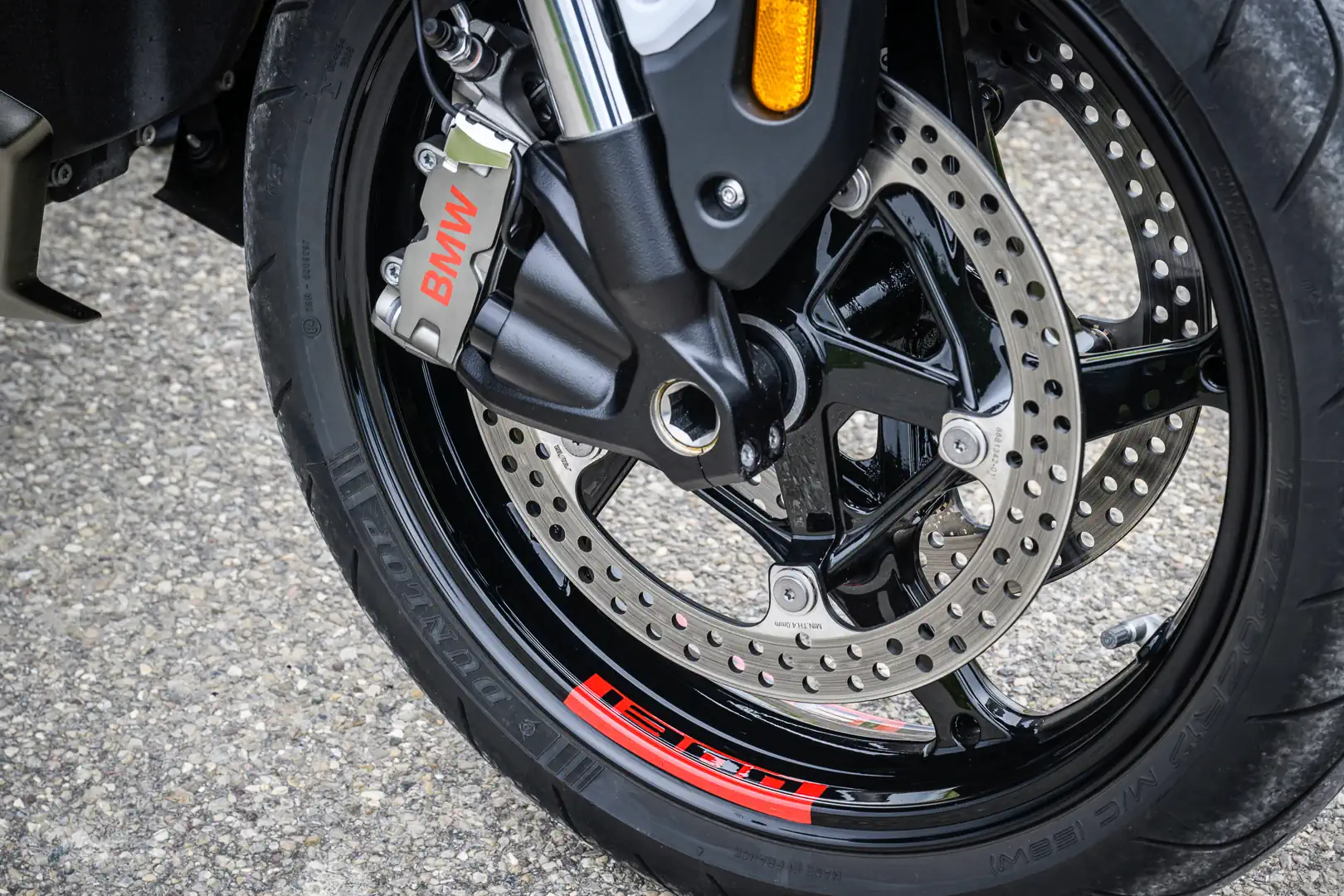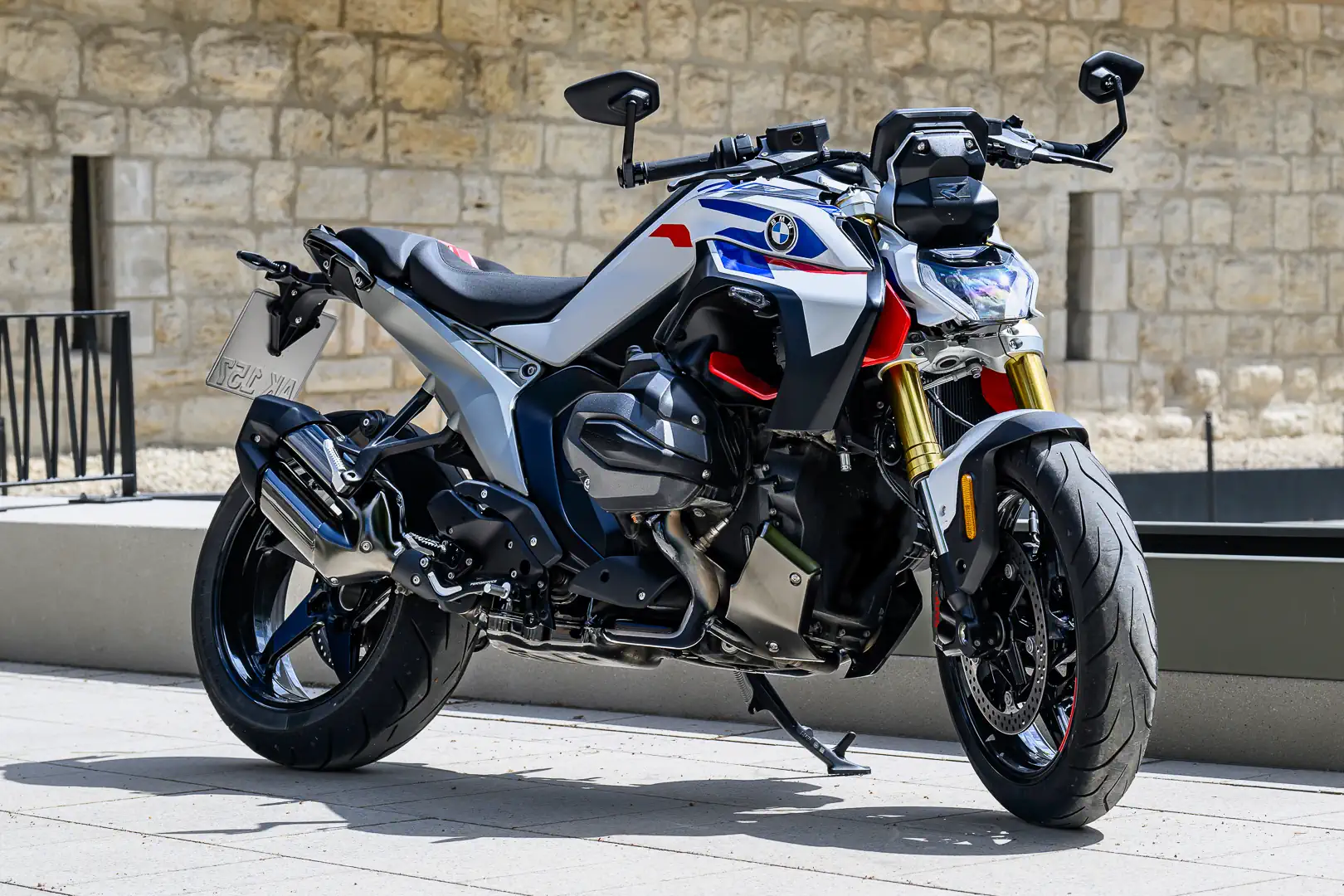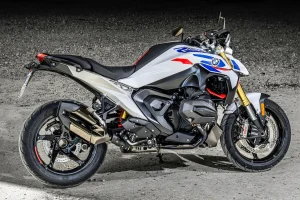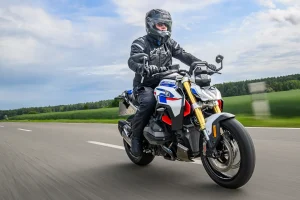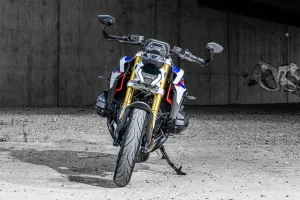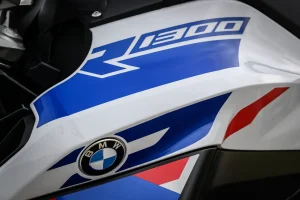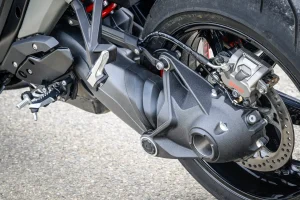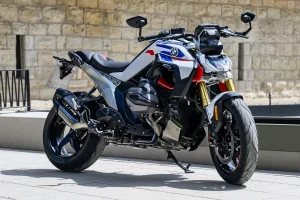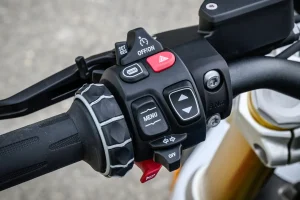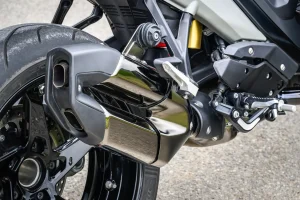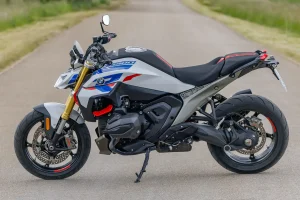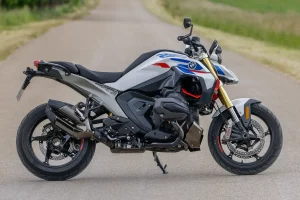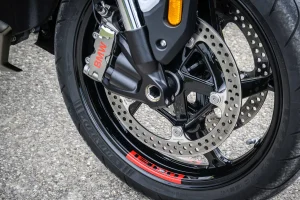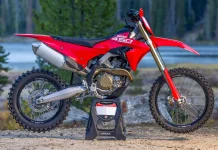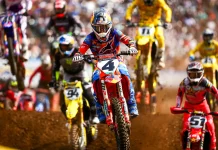As I throw my leg over the new 2026 BMW R 1300 R in the pouring rain, I’m not pleased. The last place I want to be in this weather is on a naked motorcycle, exposed to the elements, trying to push the bike through slippery German country roads just to understand how well it performs. And unless you happen to catch me at Burning Man, I’m not a fan of naked.
I had just come off the also-new R 1300 RT, with its massive front fairing and windscreen, fully protected from the elements. “This is gonna suck,” I thought to myself. To make things worse, our guide for the next stretch liked to push the pace hard. “Let’s not launch this beautiful bike—and my old ass—into the Bavarian forest,” I tell myself.
But then a funny thing happened. I fired up the engine, tucked into the motorcycle, and pulled out into the line of riders ready to rip.
And that’s exactly what we did.
As it turns out, maybe I do like naked. And as a 60-year-old man, that should scare most of you.
I must confess, I’ve long been a fan of the big boxer in sport touring form. When the R 1200 RS came out in 2015, I thought it struck the perfect balance between performance and aesthetics. I snatched one up immediately. I owned it for five years, making minor modifications to the windscreen, seating position, and handlebars to improve touring comfort. It was fantastic in many ways. With a low center of gravity, gobs of torque, and semi-active suspension, it was a blast to ride. But it did have one noticeable and significant drawback—the harder you pushed the R 1200 RS through twisty roads and canyons, the more it felt like it was fighting you. Let’s see what’s happened in the intervening 10 years.
- Riding the brand-new R 1300 R, the performance differences compared to my R 1200 RS are immediately apparent. BMW redesigned the chassis from the ground up for the 2026 R 1300 R, and it has good bones. The main frame is steel, paired with a die-cast aluminum subframe that’s more compact, stiffer, and lighter. According to BMW, the new chassis, combined with a more compact and lighter drivetrain, concentrates the mass even closer to the already-low center of gravity—translating to the noticeably improved handling I experienced. At 526 pounds wet, the R 1300 R isn’t light. However, you’d never know it, carving up Bavarian roads.
- The R 1300 R has all the nimbleness and easy handling at low speeds of my old RS, but none of its drawbacks when the riding gets spirited. In fact, the more I pushed it, the more it seemed to like it. Road conditions didn’t matter—wet or dry, off-camber or sweeping turns—the bike just wanted to go. It’s clear BMW made some serious upgrades.
- The R 1300 R has great suspension with a smarter brain. The chassis redesign is complemented by significant improvements to the suspension, which featured the Dynamic Suspension Adjustment (DSA) option on my test bike. The R 1300 R gets a new inverted 47mm fork and Evo Paralever shock setup. The new semi-active DSA system takes suspension tech to the next level. It doesn’t just adjust the firmness of the front and rear suspension—it also changes the spring stiffness in real time. That means the bike can adapt to your riding mode, road conditions, and style—whether you’re cruising, braking hard, or leaning deep into a turn.
- DSA is a more intelligent, more responsive system that improves comfort, handling, and stability. The R 1300 R is the first production motorcycle with an inverted fork capable of adjusting the spring rate dynamically. For example, when in Dynamic Sport mode, the bike actually shifts your position forward by altering the front and rear spring rates simultaneously. Brilliant.
- The boxer engine just keeps getting better. If you’re not familiar with the new 1300cc boxer engine that debuted last year on the GS platform, well, it’s fantastic. I had the 1200 boxer in my RS, then upgraded to the 1250 GS, and I found the jump to the 1250’s ShiftCam tech to be a big step forward. The 1300 feels even better. Though it may not quite be as dramatic a leap, this engine flies.
- Power output peaks at 145 horsepower and 110 ft-pounds of torque. That’s up from 136 horses and 105 ft-lbs from the 1250—a not insignificant difference. However, what’s so lovely is how usable the power is. Cruising through sleepy German towns, it’s buttery smooth. Twist the throttle on an open stretch with no speed limit, and it comes alive. Gear choice hardly seemed to matter—there was always just the right amount of torque, perfect fueling, and excellent feel through the shaft drive. Although BMW engineers assured me it’s the same powertrain used in the new R 1300 RT, it felt very different to me. That’s due in large part to the 90-plus-pound weight difference, of course. Still, the eagerness of the big twin and how quickly it spools up is impressive.
- The ergonomics are surprisingly agreeable, considering its appearance. Looking at the big R, I could already feel my back and knees twinging. BMW revised the rider triangle to enhance the bike’s sportiness. The rider sits farther forward and more over the front wheel, the footpegs are slightly farther back, and the handlebar bend is flattened out. Typically, that spells discomfort for me—not to mention a twitchier ride than I usually enjoy as an adventure bike guy. Instead, the longer I rode, the more surprised I was. I experienced little fatigue, no real discomfort. The seat is well-padded, the rearsets didn’t bother my knees, and I never felt too far over the front; I just enjoyed the ride. Once again, those crafty German engineers nailed it.
- I almost forgot to mention the brakes because they are so correctly dialed, I never thought about them. As you’d expect on a high-spec Beemer, the R 1300 R has excellent brakes—dual radially mounted four-piston calipers up front, and a single disc with a two-piston floating caliper in the rear, all managed by BMW Motorrad Integral ABS Pro. The system is linked and very effective. Though I didn’t test the optional sport brake setup, the stock brakes never felt outmatched, even during aggressive riding.
- The dash has not changed much because it didn’t need to. Like the RS and GS, the R 1300 R features BMW’s gorgeous 6.5-inch TFT screen. It’s clear, intuitive, and integrates with the smartphone-based BMW Motorrad Connected App for the usual added functionality and features.
- She sure is a sexy beast. BMW spent a lot of time refining the R 1300 R’s looks. The new sculpted, flowing design is meant to convey a more aggressive, athletic stance—and it works. It’s a big visual upgrade over the last iteration. While I spotted some Japanese and Italian naked bike styling cues, particularly up front, overall, it’s a striking design. For riders wanting something even sportier, BMW offers a wide array of performance and styling packages, plus a deep catalog of optional equipment.
- Shocker! There is a boatload of options and packages to choose from. Beyond the aforementioned sport upgrades, the R 1300 R can be extensively customized. Options include different seats, windscreens, ride modes, adaptive headlights, adaptive cruise control, front collision warning, braking assist, navigation, and luggage systems—you name it.
- The 2026 BMW R 1300 R impressed me. Starting out in the rain, I braced for a rough ride, but the R proved me wrong. Its redesigned chassis and dynamic suspension handle corners with ease, wet or dry, outshining my old R 1200 RS. The 1301cc boxer delivers smooth power in town and plenty of punch on open roads. Ergonomics kept me comfortable, despite my initial doubts, and the brakes performed flawlessly without drawing attention. Riding it hard felt natural, not forced, and it’s more versatile than I expected from a naked bike. I didn’t know if I’d warm to it, but the R 1300 R’s balance of performance and refinement makes it a standout.
Action Photography by Uwe Fischer and Markus Jahn
RIDING STYLE
- Helmet: Simpson Xcursion Bandit Carbon
- Sunglasses: Ray-Ban Wayfair II
- Jacket: Alpinestars Zaca Waterproof
- Gloves: Alpinestars Corozal v3 Drystar
- Pants: Alpinestars ST-7 2L Gore-Tex
- Boots: Alpinestars XT-8 Gore-Tex
2026 BMW R 1300 R Specs
ENGINE
- Type: Horizontally opposed twin
- Displacement: 1301cc
- Bore x stroke: 106.5 x 73mm
- Maximum power: 145 horsepower @ 7750 rpm
- Maximum torque: 110 ft-lbs @ 6500 rpm
- Top speed: 120+ mph
- Compression ratio: 13.3:1
- Fueling: EFI w/ 52mm throttle body
- Valvetrain: DOHC w/ dual profile cams; 4vpc
- Cooling: Liquid and air
- Transmission: 6-speed
- Clutch: Hydraulically actuated wet multiplate w/ slipper function
- Final drive: Shaft
CHASSIS
- Frame: Two-section w/ load-bearing engine
- Front suspension; travel: Inverted 47mm fork; 5.5 inches
- Rear suspension; travel: BMW Motorrad Evo Paralever and shock; 5.1 inches (optional sport and semi-active available)
- Wheels: Cast aluminum
- Front wheel: 17 x 3.50
- Rear wheel: 17 x 6.00
- Front tire: 120/70-17
- Rear tire: 190/55-17
- Front brakes: 310mm discs w/ radially mounted 4-piston calipers
- Rear brake: 285mm disc w/ 2-piston caliper
- ABS: BMW Motorrad Integral ABS Pro
DIMENSIONS
- Wheelbase: 59.2 inches
- Rake: 27.5 degrees
- Trail: 5.0 inches
- Seat height: 30.9 or 31.9 inches
- Fuel capacity: 4.5 gallons
- Estimated fuel consumption: 49 mpg
- Curb weight: 527 pounds
2026 BMW R 1300 R Price: from $16,595 MSRP


